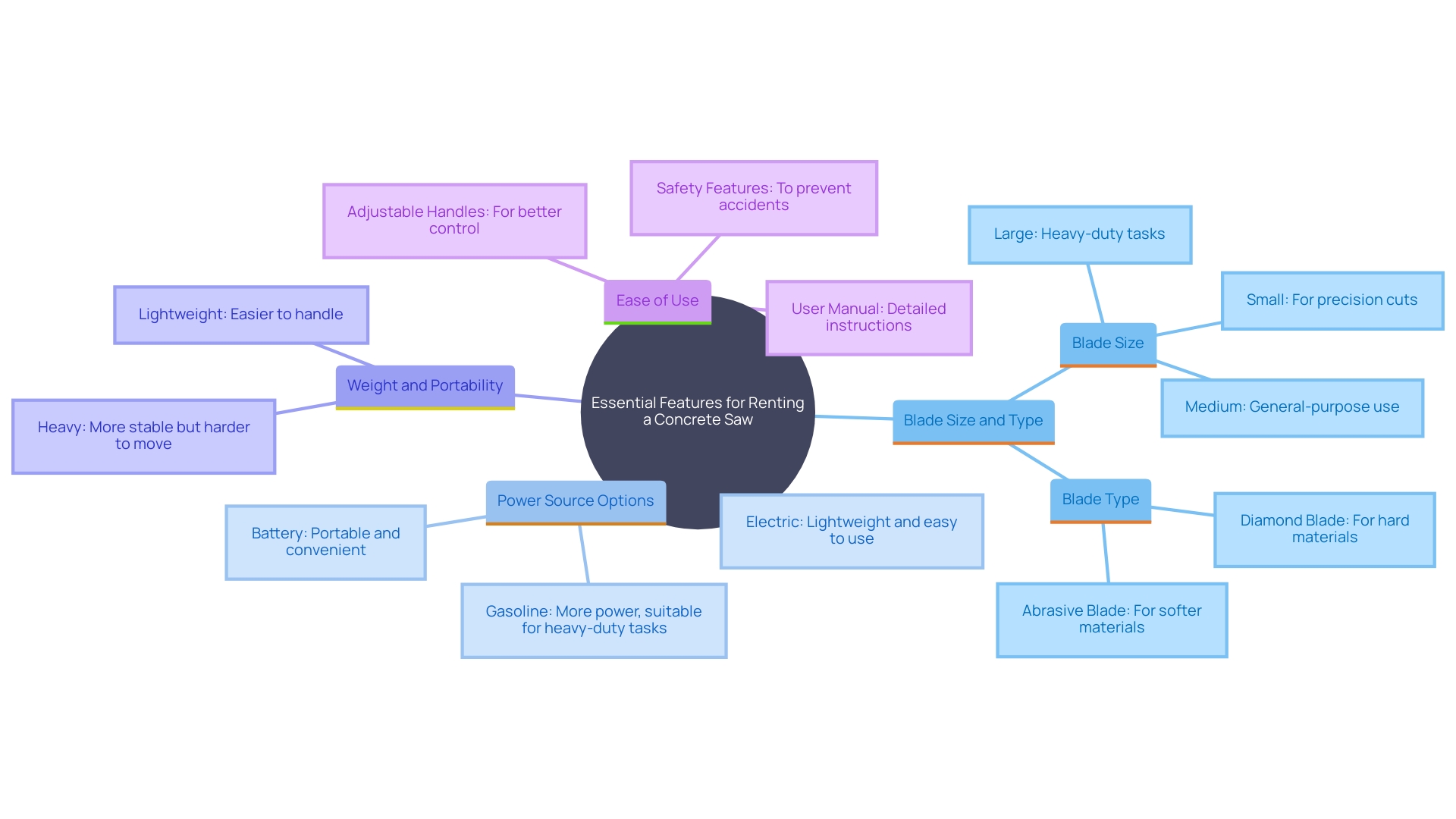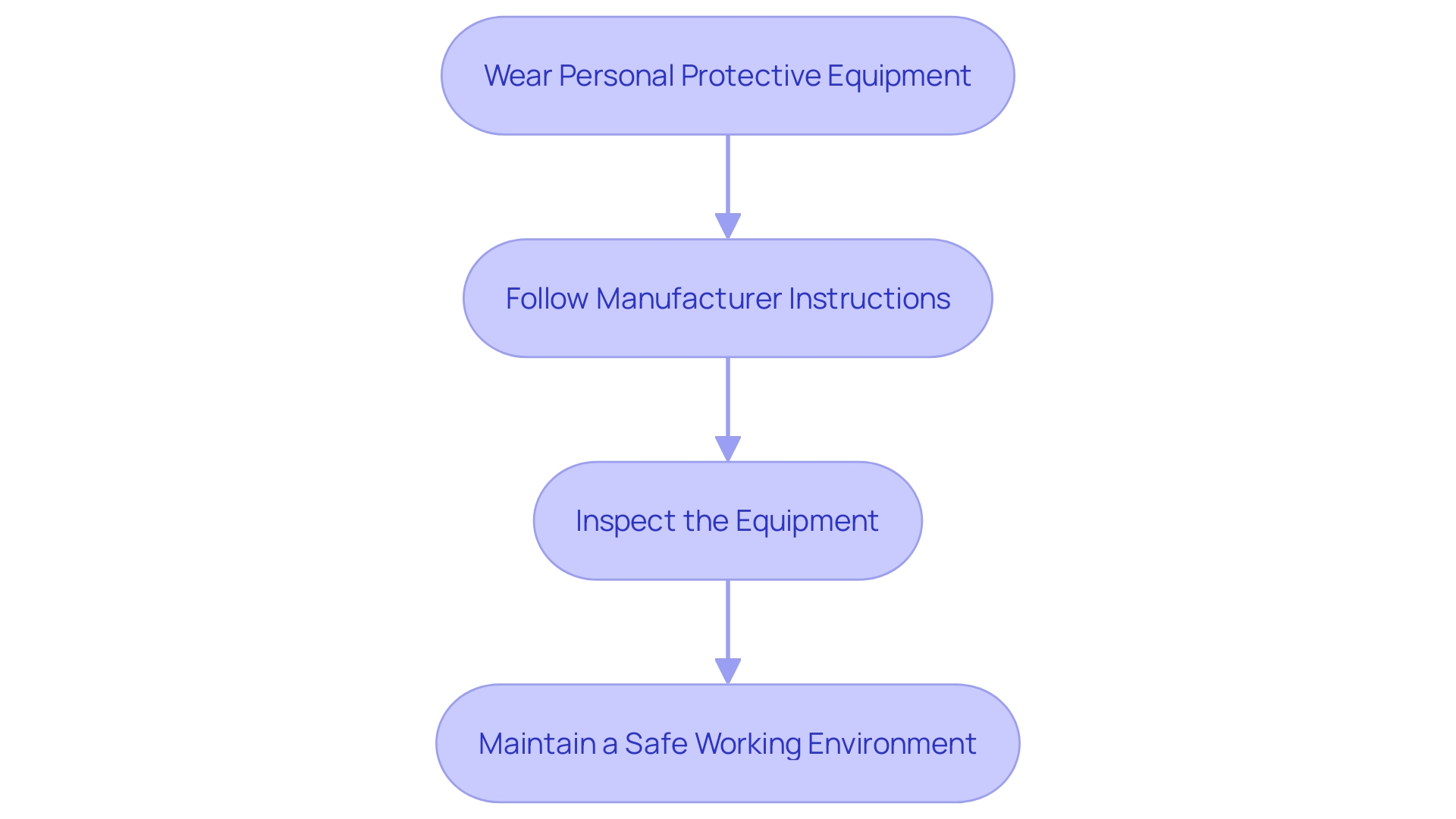Introduction
Concrete cutting projects demand precision and the right tools to ensure efficiency and safety. Navigating the options available for renting a concrete saw can be daunting, given the variety of saw types tailored to specific tasks and project scales. This article delves into the different types of concrete saws available for rent, key features to consider when selecting a saw, top rental options near you, and essential tips for choosing the best rental service.
Additionally, it highlights crucial safety considerations and provides a cost comparison between renting and buying a concrete saw. Whether tackling a small home improvement task or a larger construction project, understanding these aspects will help in making a well-informed decision, ensuring both cost-effectiveness and operational success.
Types of Concrete Saws Available for Rent
When considering concrete saw and cutter rentals, it's important to understand the various types available for different tasks:
- Handheld Saws: Perfect for small jobs and confined spaces, these saws are ideal for cutting through walls or floors with precision.
- Walk-Behind Cutters: Created for bigger tasks, these tools provide stability and are frequently utilized for slicing thick slabs. Their robust construction ensures efficient and accurate cuts.
- Wall Saws: Tailored for vertical cuts, these saws excel at creating openings in walls. Their specialized design allows for controlled and clean cuts.
- Wire Sawing Systems: Utilized for intricate cuts, wire sawing systems employ a diamond wire, making them suitable for specialized applications requiring high precision.
Key Features to Consider When Renting a Concrete Saw
When selecting the right concrete saw rental, several key features need to be considered to ensure efficiency and effectiveness for your project:
- Blade Size and Type: Choose a saw equipped with the appropriate blade for your specific job. For instance, a diamond blade offers precision for cutting through tough materials, while a general-purpose blade may suffice for simpler tasks.
- Power Source: Choose among gas, electric, or hydraulic power according to your site and specific needs. Electric saws are perfect for indoor applications because of their reduced emissions and noise, whereas gas-powered saws provide greater power for outdoor tasks.
- Weight and Portability: Consider the ease of transportation and handling. Lightweight models are more convenient for smaller jobs or projects that require frequent movement of the equipment.
- Ease of Use: Look for user-friendly features that enhance usability, such as adjustable handles, simple controls, and clear indicators, ensuring smooth operation even for less experienced users.
Leasing tools can be economical, with costs affected by the kind of item, quality, and duration of use. For example, a basic power tool hire might cost around $30 to $50 per day. Additionally, exploring tool-share programs or libraries can be an affordable option for borrowing equipment, often at minimal or no cost.

Top Options for Concrete Saw Rentals Near You
Finding a trustworthy leasing provider is crucial for any construction project. Here are some options to consider:
- Home Improvement Stores: Big-box retailers like Home Depot and Lowe’s offer a wide selection of concrete saws for rent. These stores are convenient and often have competitive prices.
- Specialty Tool Leasing Companies: Local shops that specialize in construction equipment can provide higher-end brands and more personalized services. These companies often have a deeper understanding of the tools and can offer expert advice.
- Online Platforms: Websites such as RentalYard and EquipmentTrader allow you to compare prices and availability of concrete saws in your area. These platforms provide the convenience of online booking and often feature user reviews to help you make an informed decision.
- Tool-Sharing Libraries: Community tool libraries offer another cost-effective option. These libraries allow you to borrow tools for free or at a minimal cost, making them an excellent choice for those looking to cut expenses.
According to Mansur, the leasing price for a basic power tool typically ranges from $30 to $50 per day. Costs may fluctuate depending on the kind of gear and leasing period. While renting might seem pricey, it's often more economical than buying new tools or hiring experts who bring their own instruments.
Tips for Choosing the Best Concrete Saw Rental Service
To ensure a smooth rental experience, consider these essential tips:
- Read Reviews: Checking online reviews can provide valuable insights into customer satisfaction and service quality. A study highlights that understanding customer feedback is critical for businesses to identify areas of improvement and make data-driven decisions.
- Inquire About Upkeep: It is vital to confirm that the leasing firm maintains and routinely checks their apparatus for safety and functionality. As mentioned in industry reports, strict compliance with best practices in handling tools is essential for operational efficiency and workplace safety.
- Compare Prices: Don’t settle for the first option. Competitive bidding encourages transparency and often leads to lower costs and higher quality services. Conduct thorough market research to understand current trends and evaluate the value of different offers.
- Inquire About Support: Choose a leasing service that offers guidance on using the equipment safely and effectively. Proper training and certification of operators are essential to prevent common mistakes and ensure the safety and longevity of operations.
Safety Considerations When Using a Rented Concrete Saw
Safety is paramount when operating concrete saws. Here are key precautions to ensure a safe working environment:
-
Wear Personal Protective Equipment (PPE): Equip yourself with safety glasses, gloves, and ear protection. These items are essential to prevent injuries and mitigate risks.
-
Follow Manufacturer Instructions: Always read the user manual provided with the rental saw. Comprehending the specific operational guidelines aids in utilizing the tools safely and effectively.
-
Inspect the Equipment: Prior to use, thoroughly check the saw for any damage or wear. Ensuring the equipment is in good condition is crucial for safe operation.
-
Work in a Safe Environment: Clear your work area of any hazards and ensure proper ventilation, especially when using gas-powered saws. Good safety practices, as taught in Occupational Safety and Health Administration (OSHA) training, emphasize hazard elimination and mitigation before relying on PPE.
Adhering to these safety measures greatly reduces the risk of accidents and promotes a safer working environment.

Cost Comparison: Buying vs. Renting a Concrete Saw
Deciding between renting and purchasing a concrete saw can greatly affect your budget and operational efficiency. Renting a concrete saw is ideal for short-term or infrequent use, with costs typically ranging from $50 to $200 per day. This option offers flexibility without the burden of maintenance or storage, making it suitable for one-time endeavors. On the other hand, purchasing a concrete saw, which can cost between $300 and over $3,000, is a substantial upfront investment. However, owning can be more cost-effective for contractors with ongoing needs, offering long-term savings and the advantage of immediate availability. As supply-chain stresses have eased, more cash buyers are entering the market, potentially shortening sales cycles and impacting rental demand. According to industry experts, balancing these options requires careful consideration of your project timeline, budget constraints, and long-term equipment needs.
Conclusion
Understanding the nuances of concrete saw rentals is essential for ensuring project success and safety. Different types of saws cater to specific tasks, from handheld models for small jobs to robust walk-behind saws for larger projects. Each type has distinct features, and knowing which one aligns with project needs is critical for achieving precise cuts and maintaining efficiency.
Selecting the right rental service involves considering key features such as blade size, power source, and portability. These factors directly impact usability and effectiveness. Additionally, exploring various rental options, from home improvement stores to specialty rental shops and online platforms, can lead to better pricing and availability.
Engaging with community tool libraries also presents a cost-effective alternative for those on a budget.
Safety cannot be overstated when operating concrete saws. Adhering to safety protocols, using personal protective equipment, and maintaining equipment are vital steps in mitigating risks. Moreover, comparing rental services and assessing customer feedback can enhance the overall rental experience.
Ultimately, the decision to rent or buy a concrete saw hinges on project frequency and budget considerations. Renting is often more economical for short-term projects, while purchasing may be more beneficial for ongoing needs. Weighing these options carefully allows for informed choices that align with both immediate and long-term project goals.




